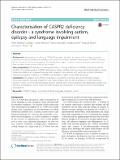Files in this item
Characterisation of CASPR2 deficiency disorder - a syndrome involving autism, epilepsy and language impairment
Item metadata
| dc.contributor.author | Rodenas-Cuadrado, Pedro | |
| dc.contributor.author | Pietrafusa, Nicola | |
| dc.contributor.author | Francavilla, Teresa | |
| dc.contributor.author | La Neve, Angela | |
| dc.contributor.author | Striano, Pasquale | |
| dc.contributor.author | Vernes, Sonja C | |
| dc.date.accessioned | 2021-03-24T12:30:08Z | |
| dc.date.available | 2021-03-24T12:30:08Z | |
| dc.date.issued | 2016-02-03 | |
| dc.identifier | 272112579 | |
| dc.identifier | 94f4e681-dffe-4c3f-806e-ee7d9dddba5d | |
| dc.identifier | 26843181 | |
| dc.identifier | 84956640101 | |
| dc.identifier.citation | Rodenas-Cuadrado , P , Pietrafusa , N , Francavilla , T , La Neve , A , Striano , P & Vernes , S C 2016 , ' Characterisation of CASPR2 deficiency disorder - a syndrome involving autism, epilepsy and language impairment ' , BMC Medical Genetics , vol. 17 , 8 . https://doi.org/10.1186/s12881-016-0272-8 | en |
| dc.identifier.issn | 1471-2350 | |
| dc.identifier.other | PubMedCentral: PMC4739328 | |
| dc.identifier.other | ORCID: /0000-0003-0305-4584/work/86538535 | |
| dc.identifier.uri | https://hdl.handle.net/10023/21700 | |
| dc.description | This work was supported by a Marie Curie Career Integration Grant awarded to S.C.V. and by the Max Planck Society. We are grateful to the family for their consent in undertaking this study. | en |
| dc.description.abstract | Background: Heterozygous mutations in CNTNAP2 have been identified in patients with a range of complex phenotypes including intellectual disability, autism and schizophrenia. However heterozygous CNTNAP2 mutations are also found in the normal population. Conversely, homozygous mutations are rare in patient populations and have not been found in any unaffected individuals. Case presentation: We describe a consanguineous family carrying a deletion in CNTNAP2 predicted to abolish function of its protein product, CASPR2. Homozygous family members display epilepsy, facial dysmorphisms, severe intellectual disability and impaired language. We compared these patients with previously reported individuals carrying homozygous mutations in CNTNAP2 and identified a highly recognisable phenotype. Conclusions: We propose that CASPR2 loss produces a syndrome involving early-onset refractory epilepsy, intellectual disability, language impairment and autistic features that can be recognized as CASPR2 deficiency disorder. Further screening for homozygous patients meeting these criteria, together with detailed phenotypic and molecular investigations will be crucial for understanding the contribution of CNTNAP2 to normal and disrupted development. | |
| dc.format.extent | 7 | |
| dc.format.extent | 502157 | |
| dc.language.iso | eng | |
| dc.relation.ispartof | BMC Medical Genetics | en |
| dc.subject | Autistic disorder/genetics | en |
| dc.subject | Child, preschool | en |
| dc.subject | Epilepsy/genetics | en |
| dc.subject | Female | en |
| dc.subject | Gene deletion | en |
| dc.subject | Heterozygote | en |
| dc.subject | Humans | en |
| dc.subject | Infant | en |
| dc.subject | Intellectual disability/genetics | en |
| dc.subject | Language disorders/genetics | en |
| dc.subject | Membrane proteins/deficiency | en |
| dc.subject | Mutation | en |
| dc.subject | Nerve tissue proteins/deficiency | en |
| dc.subject | Pedigree | en |
| dc.subject | Phenotype | en |
| dc.subject | Sequence analysis, DNA | en |
| dc.subject | Syndrome | en |
| dc.subject | QH301 Biology | en |
| dc.subject | QH426 Genetics | en |
| dc.subject | RC0321 Neuroscience. Biological psychiatry. Neuropsychiatry | en |
| dc.subject.lcc | QH301 | en |
| dc.subject.lcc | QH426 | en |
| dc.subject.lcc | RC0321 | en |
| dc.title | Characterisation of CASPR2 deficiency disorder - a syndrome involving autism, epilepsy and language impairment | en |
| dc.type | Journal article | en |
| dc.contributor.institution | University of St Andrews. School of Biology | en |
| dc.identifier.doi | https://doi.org/10.1186/s12881-016-0272-8 | |
| dc.description.status | Peer reviewed | en |
This item appears in the following Collection(s)
Items in the St Andrews Research Repository are protected by copyright, with all rights reserved, unless otherwise indicated.

